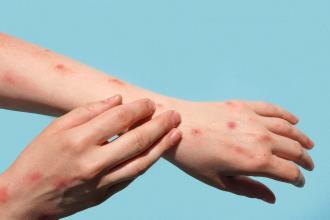Monkeypox: What primary care providers need to know about testing
Since May 2022, monkeypox infections have been reported in many countries where they had not been seen previously, including Canada. Timely diagnostic testing using polymerase chain reaction (PCR) is key for both clinical management and public health control measures in British Columbia. This article provides guidance to primary care providers on when, who, and how to test for monkeypox infection, which can be done safely in primary care settings.
Clinical presentation
The typical clinical presentation consists of a short prodrome, followed by the progressive development of a rash and lesions. The clinical presentation can be highly variable, with some individuals experiencing no prodrome, and a range of lesion patterns, from small lesions in a discrete area to large numbers of lesions, often in the genital region, including the perianal and anal regions.[1]
The diagnosis of monkeypox can be challenging, given the broad differential diagnosis and the nonspecific nature of the prodromal illness. Clinicians should consider these other conditions and test for them as indicated: syphilis, herpes simplex virus (HSV), molluscum contagiosum, and varicella zoster virus (VZV).
Who to test for monkeypox
Testing for monkeypox should be based on clinical judgment, taking into account patient history, physical examination, and epidemiologic factors.
At the time of writing, in the current Canadian monkeypox outbreak, nearly all cases have occurred in the context of close, intimate contact during sex, in members of the gay, bisexual, and other men-who-have-sex-with-men communities. While monkeypox cases have been identified outside of this population globally, including among women and children, these cases have been rare.[2] For individuals outside of the current risk groups, other types of infections remain higher on the differential, but it is important to remain vigilant to the spread of monkeypox within the broader community.
How to collect specimens for monkeypox testing
Testing for monkeypox should be performed using appropriate personal protective equipment, which includes droplet and contact precautions (gown, gloves, medical mask, and eye protection). This will also provide protection for other infections included in the differential diagnosis.
The clinical presentation should guide diagnostic testing.
If rash/lesions are present: The highest yield for monkeypox PCR testing is from skin and mucosal lesions. If lesions are present on different areas of the body, use a different swab for different anatomic areas. Swab 2–3 lesions per area, unroof vesicles, and/or vigorously swab dry or crusted lesions using a single swab. In addition to lesion swabs, do oropharyngeal and rectal swabs where clinically appropriate (e.g., symptomatic proctitis).[3]
If prodromal symptoms are present but there is no evidence of skin lesions: Collect an oropharyngeal and a rectal swab, as this will maximize sensitivity of detection. Where appropriate, consult with the BCCDC microbiologist on call (604 661-7033) and/or your local hospital microbiologist to ensure that all possible etiologic agents are considered.
The type of swab used to sample possible monkeypox lesions is the same swab normally used for HSV/VZV testing and should be placed in Universal Transport Medium. Multiple viruses (e.g., HSV, VZV, enterovirus, monkeypox) can be detected from a single sample collection. Monkeypox PCR testing is offered at the BCCDC Public Health Laboratory and select other regional laboratories.
Testing is not recommended for individuals without symptoms, even for contacts to a confirmed monkeypox case, if they remain asymptomatic.
Advice to patients with suspected monkeypox
The turnaround time for testing is 24 hours once specimens are received at the BCCDC Public Health Laboratory. While test results are pending, patients suspected of having monkeypox should be instructed to limit their contact with others and practise frequent hand and respiratory hygiene (including wearing a medical mask if out in public). Lesions should be covered whenever possible, and contaminated objects should be handled by the case only. If test results are negative, these measures can be discontinued.
If monkeypox infection is confirmed
Advise the patient to continue infection control measures until all lesions have healed (i.e., the scabs have fallen off and re-epithelialization has occurred). Local public health will follow up with the patient for case and contact management. Treatment is largely supportive and focused on symptoms.
—Troy Grennan, MD, MSc, FRCPC
—Agatha Jassem, PhD, (D)ABMM, FCCM
—Mel Krajden, OBC, MD, FRCPC
—Mark Gilbert, MD, MHSc, FRCPC
For more information:
- Detailed information on sample types and containers can be found by searching the eLab Handbook for monkeypox (www.elabhandbook.info/phsa).
- Additional detailed information about monkeypox for health care providers can be found on the BCCDC website (www.bccdc.ca/health-professionals/clinical-resources/monkeypox).
hidden
This article is the opinion of the BC Centre for Disease Control and has not been peer reviewed by the BCMJ Editorial Board.
 |
| This work is licensed under a Creative Commons Attribution-NonCommercial-NoDerivatives 4.0 International License. |
References
1. Thornhill JP, Barkati S, Walmsley S, et al. Monkeypox virus infection in humans across 16 countries—April–June 2022. N Engl J Med 2022;387:679-691.
2. World Health Organization. Joint ECDC-WHO Regional Office for Europe monkeypox surveillance bulletin. Accessed 25 August 2022. https://monkeypoxreport.ecdc.europa.eu.
3. BC Centre for Disease Control. Monkeypox—Information for health care providers. Accessed 25 August 2022. www.bccdc.ca/health-professionals/clinical-resources/monkeypox.

